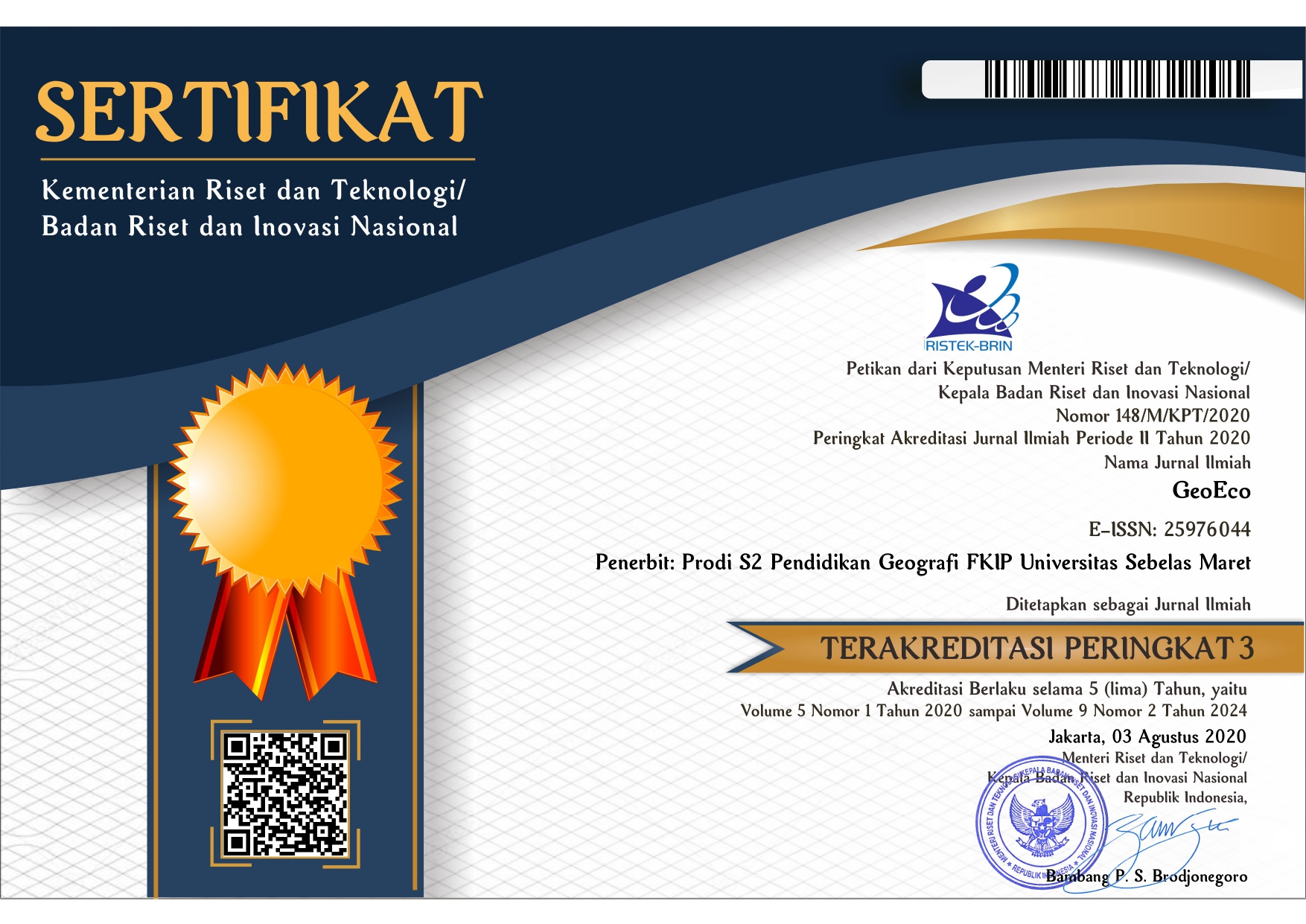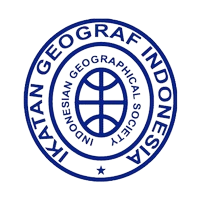MANGROVE HEALTH ANALYSIS USING SENTINEL-2A IMAGE WITH NDVI CLASSIFICATION METHOD
Abstract
This study aims to determine 1) the mangrove vegetation density index, 2) the health of mangrove plants in Sungai Batang Village to Kuala Secapah. The data used in this study is the image of Sentinel-2A, dated June 8, 2020. The data taken are vegetation density (NDVI) and mangrove health. The method in this study uses the vegetation index transformation (NDVI). Data analysis used the supervised classification method and the vegetation density index (NDVI). The results showed that the NDVI value of -1 – 0.32 indicates a sparse vegetation density, a value of 0.33 – 0.42 indicates a medium density and 0.43 – 1 indicates a dense density. From this NDVI index value, it can be used as a basis for classifying the health of mangrove vegetation. The health of mangrove vegetation based on the vegetation index value of 0.43 – 1 (meet) indicates that the health of the mangrove vegetation is very good. Vegetation value 0.33 – 0.42 (moderate) indicates good health of mangrove vegetation and vegetation index value -1 – 0.32 (rare) indicates poor vegetation health. Mangrove health level is very good with an area of 3.0314 km2, healthy has an area of 0.204806 km2 and poor health has an area of 0.625875 km2.
Keywords
Full Text:
PDFReferences
Andriansah, R., Ulqodry, T. Z., & Ningsih, E. N. (2020). ANALISIS KONDISI MANGROVE BERDASARKAN NDVI (NORMALIZED DIFFERENCE VEGETATION INDEX) DAN TUTUPAN KANOPI MENGGUNAKAN CITRA SENTINEL-2 DI PULAU PAYUNG, MUARA SUNGAI MUSI, BANYUASIN, SUMATERA SELATAN. Sriwijaya University.
Ardiansyah, D. M., & Buchori, I. (2014). Pemanfaatan citra satelit untuk penentuan lahan kritis mangrove di Kecamatan Tugu, Kota Semarang. Geoplanning: Journal of Geomatics and Planning, 1(1), 1–12.
Arshad, M., Eid, E. M., & Hasan, M. (2020). Mangrove health along the hyper-arid southern Red Sea coast of Saudi Arabia. Environmental Monitoring and Assessment, 192(3), 1–15.
Cissell, J. R., Delgado, A. M., Sweetman, B. M., & Steinberg, M. K. (2018). Monitoring mangrove forest dynamics in Campeche, Mexico, using Landsat satellite data. Remote Sensing Applications: Society and Environment, 9, 60–68.
Collins, D. S., Avdis, A., Allison, P. A., Johnson, H. D., Hill, J., Piggott, M. D., Hassan, M. H. A., & Damit, A. R. (2017). Tidal dynamics and mangrove carbon sequestration during the Oligo–Miocene in the South China Sea. Nature Communications, 8(1), 1–12.
Danoedoro, P. (2012). Pengantar penginderaan jauh digital. Penerbit Andi, Yogyakarta.
Duke, N., Nagelkerken, I., Agardy, T., Wells, S., & Van Lavieren, H. (2014). The importance of mangroves to people: A call to action. United Nations Environment Programme World Conservation Monitoring Centre.
Friess, D. A., & Webb, E. L. (2014). Variability in mangrove change estimates and implications for the assessment of ecosystem service provision. Global Ecology and Biogeography, 23(7), 715–725.
Ishtiaque, A., Myint, S. W., & Wang, C. (2016). Examining the ecosystem health and sustainability of the world’s largest mangrove forest using multi-temporal MODIS products. Science of the Total Environment, 569, 1241–1254.
Jia, M., Wang, Z., Wang, C., Mao, D., & Zhang, Y. (2019). A new vegetation index to detect periodically submerged Mangrove forest using single-tide sentinel-2 imagery. Remote Sensing, 11(17), 2043.
Kamal, M., Hartono, H., Wicaksono, P., Adi, N. S., & Arjasakusuma, S. (2016). Assessment of Mangrove Forest Degradation Through Canopy Fractional Cover in Karimunjawa Island, Central Java, Indonesia. Geoplanning: Journal of Geomatics and Planning, 3(2), 107–116.
Kehutanan, D. (2005). Pedoman inventarisasi dan identifikasi lahan kritis mangrove. Direktorat Jenderal Rehabilitasi Lahan Dan Perhutanan Sosial Departemen Kehutanan. Jakarta.
Khakhima, N., Putra, A. C. P., & Widhaningtyas, T. U. (2018). ESTIMATING MANGROVE FOREST DENSITY USING GAP FRACTION METHOD AND VEGETATION TRANSFORMATION INDICES APPROACH. Geoplanning: Journal of Geomatics and Planning, 5(1), 35–42.
Kuenzer, C., Bluemel, A., Gebhardt, S., Quoc, T. V., & Dech, S. (2011). Remote sensing of mangrove ecosystems: A review. Remote Sensing, 3(5), 878–928.
Lee, T.-M., & Yeh, H.-C. (2009). Applying remote sensing techniques to monitor shifting wetland vegetation: A case study of Danshui River estuary mangrove communities, Taiwan. Ecological Engineering, 35(4), 487–496.
Noor, Y. R., Khazali, M., & Suryadiputra, I. N. N. (2006). Panduan pengenalan mangrove di Indonesia. Ditjen PHKA.
Nordhaus, I., Toben, M., & Fauziyah, A. (2019). Impact of deforestation on mangrove tree diversity, biomass and community dynamics in the Segara Anakan lagoon, Java, Indonesia: A ten-year perspective. Estuarine, Coastal and Shelf Science, 227, 106300.
Nurhaliza, A. P., Damayanti, A., & Dimyati, M. (2021). Monitoring Area and Health Changes of Mangrove Forest Using Multitemporal Landsat Imagery in Taman Hutan Raya Ngurah Rai, Bali Province. IOP Conference Series: Earth and Environmental Science, 673(1), 12050.
Richards, D. R., & Friess, D. A. (2016). Rates and drivers of mangrove deforestation in Southeast Asia, 2000–2012. Proceedings of the National Academy of Sciences, 113(2), 344–349.
Schaduw, J. N. W. (2018). Distribusi dan karakteristik kualitas perairan ekosistem mangrove pulau kecil Taman Nasional Bunaken. Majalah Geografi Indonesia, 32(1), 40–49.
Susiana, S. (2015). Analisis kualitas air ekosistem mangrove di estuari Perancak, Bali. Agrikan: Jurnal Agribisnis Perikanan, 8(1), 42–49.
Umarhadi, D., & Syarif, A. (2017). Regression model accuracy comparison on mangrove canopy density mapping. Intern Confer on Scien and Techn, 2(7), 1–10.
Refbacks
- There are currently no refbacks.












.png)

